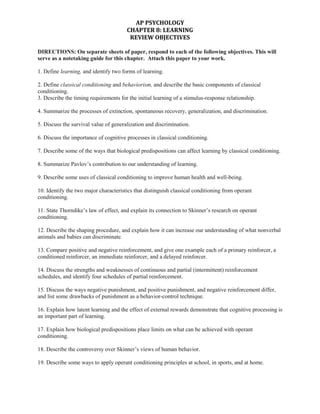
Chapter 8 review qs
- 1. DIRECTIONS: On separate sheets of paper, respond to each of the following objectives. This will serve as a notetaking guide for this chapter. Attach this paper to your work. <br />1. Define learning, and identify two forms of learning.<br />2. Define classical conditioning and behaviorism, and describe the basic components of classical conditioning. <br />3. Describe the timing requirements for the initial learning of a stimulus-response relationship. <br />4. Summarize the processes of extinction, spontaneous recovery, generalization, and discrimination. <br />5. Discuss the survival value of generalization and discrimination.<br />6. Discuss the importance of cognitive processes in classical conditioning. <br />7. Describe some of the ways that biological predispositions can affect learning by classical conditioning. <br />8. Summarize Pavlov’s contribution to our understanding of learning. <br />9. Describe some uses of classical conditioning to improve human health and well-being.<br />10. Identify the two major characteristics that distinguish classical conditioning from operant conditioning.<br />11. State Thorndike’s law of effect, and explain its connection to Skinner’s research on operant conditioning.<br />12. Describe the shaping procedure, and explain how it can increase our understanding of what nonverbal animals and babies can discriminate.<br />13. Compare positive and negative reinforcement, and give one example each of a primary reinforcer, a conditioned reinforcer, an immediate reinforcer, and a delayed reinforcer.<br />14. Discuss the strengths and weaknesses of continuous and partial (intermittent) reinforcement schedules, and identify four schedules of partial reinforcement.<br />15. Discuss the ways negative punishment, and positive punishment, and negative reinforcement differ, and list some drawbacks of punishment as a behavior-control technique.<br />16. Explain how latent learning and the effect of external rewards demonstrate that cognitive processing is an important part of learning.<br />17. Explain how biological predispositions place limits on what can be achieved with operant conditioning. <br />18. Describe the controversy over Skinner’s views of human behavior. <br />19. Describe some ways to apply operant conditioning principles at school, in sports, and at home. <br />20. Identify the major similarities and differences between classical and operant conditioning.<br />21. Describe the process of observational learning, and explain the importance of the discovery of mirror neurons. <br />22. Describe Bandura’s findings on what determines whether we will imitate a model. <br />23. Discuss the impact of prosocial modeling.<br />24. Explain why correlations cannot prove that watching violent TV causes violent behavior, and cite some experimental evidence that helps demonstrate a cause-effect link.<br />
